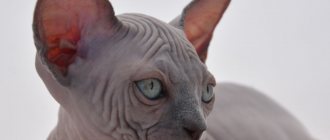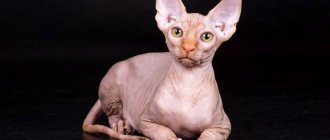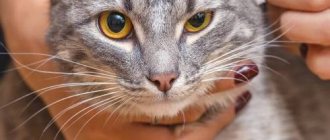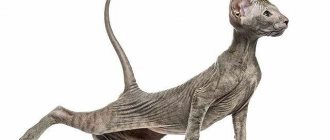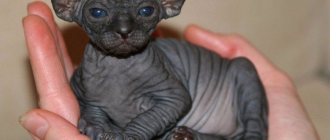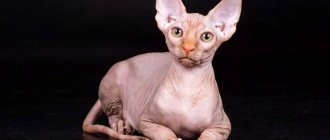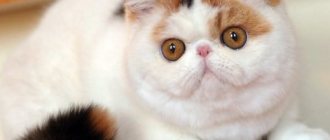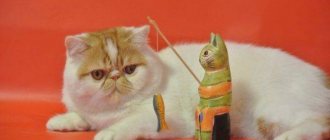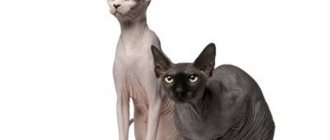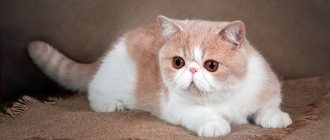Video
* We invite you to watch a video about the Canadian Sphynx . In fact, in front of you is a playlist in which you can select and watch any of 20 videos about a given cat breed by simply clicking on the button in the upper right corner of the window. In addition, the material contains quite a lot of photos. By looking at them you can find out what the Canadian Sphynx looks like.
In this article:
|
The Canadian Sphynx is a rather unusual cat. When you see these creatures, you get the impression that they came to us from another planet. They are called figurine cats. Sphinxes are very similar to people; they like to sleep under a blanket, with their heads on the pillow, and do not look away for a long time, which is not typical for other animals.
Tortoiseshells
This group of colors of the Canadian Sphynx is characterized by a coloring reminiscent of a tortoiseshell - black, cream, red specks and spots. The nose and paw pads are also motley.
Turtle cinnamon
The main tone is cinnamon. The specks are darker or red.
Turtle "lavender"
On the skin of a delicate lavender tone there are dark lavender, creamy inclusions.
Turtle cream
The main color is fawn. A darker cream or fawn “shell” runs along it.
Tortoiseshell color of sphinxes:
History of the origin of the Canadian Sphynx
Unlike other hairless cats, this breed is the only one that has received worldwide recognition. For more than 50 years, sphinxes have been passing on their characteristics in a recessive manner. The other two varieties are only on the path of formation. The first mentions of hairless cats date back to antiquity. Presumably, the owners of the breed were also the Aztecs.
Representatives of this species were nicknamed Mexican hairless and at the end of the 20th century they were actively represented at exhibitions. However, the last pair disappeared in the early 1930s, leaving no legacy. In this regard, the continuation of the family ended. The origin of the species remains unknown.
Interesting fact: The Mexican Hairless had a long body, amber eyes, and excessively long whiskers, which the Canadian Sphynx does not have. By winter, such individuals grew long fluffy hair on their backs and tails, which quickly fell out in the spring. Scientists consider the breed to be related to the Don Sphynx due to its long mustache.
At some point, hairless babies began to appear in all corners of the planet. However, no one has attempted to cross bald creatures with each other. So it is difficult to say whether the Sphynx turned out to be a descendant of these individuals, or whether this happened in 1966 in Canada, when a mutation provoked the birth of a hairless kitten from furry parents.
The baby was named Prune. Soon he was crossed with his own mother and the kittens, surprisingly, were also born without fur. To preserve the Prune gene, it was crossed with daughters and granddaughters. The first representative of the breed lived 28 years. It turned out that the babies needed special care and many died after birth.
A few years later, the short-haired cat gave birth to a hairless kitten, who was nicknamed Epidermis. A year later, by coincidence, a hairless baby was born in the same city and they ended up in the same nursery. It was here that this couple became the founders of a new elite breed.
"Tabby"
On the animal’s legs there are visible “necklaces” on the neck. The tail is also “ringed”. On the forehead the stripes form the letter “M”. A bizarre butterfly-shaped pattern spreads from the eyes along the cat’s cheeks. There are uniform stripes throughout the body.
The color variations of "tabby" are largely the same as solid colors. The animal’s body may have silver, lavender, fawn, brown, blue, chocolate, red, cinnamon, and cream spots.
Silver tabby
There are black markings on a cold silver background. Lips and chin are earthy in color.
Brown tabby
The main tone is copper, brown. There is a black pattern running across it. The chin, eye rims, and lips should be the same color. Hind legs - with black heels.
Blue tabby
The main shade is silver, pale gray. A more saturated blue pattern runs along it - the contrast is visible to the naked eye.
Red tabby
The main tone is warm soft red. The pattern is rich red.
Cream tabby
The main shade is pale soft cream. The pattern is buff color or a richer “cream”.
Chocolate tabby
Available in two varieties:
- Chocolate chestnut. The skin is a delicate, warm fawn color. There is a rich chestnut pattern running along it.
- Chocolate silver. The main tone is grayish with a cold metallic tint. It has chocolate-colored markings.
Cinnamon tabby
Again two variations are allowed:
- Cinnamon tabby. The main tone is light honey. The pattern is a rich cinnamon color.
- Cinnamon-silver tabby. The main color is metallic, “shiny silver”. Decorated about.
Lavender tabby
Breed standards also allow two varieties:
- Lavender tabby. The skin tone is pale lavender with a pinkish tone. The markings are a rich lavender (gray-lilac) hue.
- Lavender-silver tabby. Background color – cold milky, “transparent silver”. There is a darker lavender pattern running across it.
Fawn Tabby
The main shade is “ivory”. The pattern on the animal's skin is fawn, yellowish-brown.
Tiger type "Canadians":
Canadian Sphynx - description of the breed
The appearance of pets creates the impression of majestic, graceful creatures. The breed is considered decorative. Its main feature is the absence of hair on its muscular body. They have a soft fluff that feels like velor. The creatures reach average sizes weighing from 3 to 5 kilograms.
There is a slight curvature on the paws, the toes are long, with large pads. When cats walk, it looks like they are walking in heels. They do this elegantly, with a beautiful gait. Fit physique, neat proportions. The head has large ears and large eyes. The tail is long, tapering towards the end.
There are translucent hairs on the paws, bridge of the nose, tail and ears. The greatest number of them is on the muzzle, in the area of the ears and neck. Other areas have fluff or lack of vegetation. The skin is thick, elastic, folded. Babies are born completely wrinkled and remain in this state for up to a month. There are either no mustaches at all, or they are very short.
In newborn kittens, the ears remain drooping until 3 weeks of life. The larger they grow, the later they will rise. There is no hair inside the ear. The chest is wide, the belly is round, as if the cat had just eaten. There may be a tassel at the tip of the tail. The skin pigment is pronounced, so the color is easy to distinguish. The skin is very warm to the touch.
The lemon-shaped eyes give the animals a unique expression as well as an alien appearance. The distance between them can exceed the size of the eyes themselves. The lack of fur has given rise to the myth that Sphynx cats are suitable for allergy sufferers. However, this is not true, since the disease manifests itself in the proteins in the creatures’ saliva and in the sebaceous glands.
Despite their strong build, Canadians are considered fragile creatures. The nose is straight. The breed standard requires the presence of a pronounced dimple between the forehead and nose. Eye color usually harmonizes with skin color. The neck is of medium length. The front paws have a wide set.
How to choose a kitten
It is best to purchase a kitten from trusted breeders, and not from a pet store or poultry market. Only in this case does the buyer have a guarantee that he will not be deceived by selling an animal of a different breed, and that the baby will be healthy and socialized.
A healthy little sphinx is cheerful, cheerful, energetic, his eyes sparkle. Apathetic behavior, dull eyes with signs of watery eyes indicate poor health. The kitten must have absolutely clean ears and nose without any discharge. Everything under the tail must also be clean; no discharge is allowed. If the kitten is depressed, hides, does not come to your hands, meows pitifully or hisses, then this most likely means that he is sick.
Kittens are usually released to their owners no earlier than they reach 3 months of age. This period is enough for the baby to learn manners and rules of behavior from his mother. Also by this age it becomes clear whether he meets all breed standards. It is important that at this time the vaccinations that the kitten should have at the time of transfer to a new family are completed. If, nevertheless, you fall in love with a specific kitten and you are afraid of not having time to buy it, then you can reserve the baby by drawing up a preliminary agreement with the breeder and making an advance payment.
Signs of purebredness in Canadian Sphynx cats appear very early, so by the time of purchase, kittens must have all the parameters provided for by the standard.
Sphynx kittens exhibit breed characteristics from an early age
The choice of the sex of the animal depends on the preferences of the owner, since the characters of a cat and a male cat are quite different. If the future owner of the Sphynx plans to receive income from breeding, then he should take a female. But females usually cost more.
To distinguish the Canadian Sphynx from the Don or Peterbald, it is enough to pay attention to their appearance.
External differences between the Peterbald, Canadian and Don Sphynx can be detected immediately
Table: differences between the Canadian, Don Sphynx and Peterbald
| Don Sphynx | Canadian Sphynx | Peterbald | |
| Mustache | Often found | None | Most often absent, but sometimes present |
| Head | Wedge-shaped | More rounded | Narrow, long, with a long nose |
| Eyes | Almond-shaped | Lemon shaped | Slanted, almond-shaped |
| Coat | There are both completely hairless cats and those covered with fluff or partially fur. | The body is covered with fluff | They come both naked and with fur. |
| Paws | Middle length | Longer than the Don Sphynx | Long and slender |
| Tail | Straight | Tapers towards the end | Long and thin at the base |
| Ears | The tips are slightly rounded, stand high and wide, slightly tilted forward | Large, wide at the base, erect | Low set, set apart to the sides. |
How much do Sphynx kittens cost?
First you need to figure out what the price depends on. First of all, this breed has its own standards. Consequently, after the birth of kittens, they are assigned certain classes:
- pet class is a category of kittens that do not pass any of the points of the standard, but will be wonderful as pets; this also includes animals that do not have a pedigree;
- breeding class - assigned to those cats that cannot participate in exhibitions themselves, but are used in breeding offspring;
- show class - a category of kittens that meet all standard criteria and can participate in exhibitions; the price of such babies depends on the amount of wool, as well as their gender.
The cost of kittens directly depends on the class of the animal:
- pets (pet class), together with mandatory castration, will cost an average of 8–15 thousand rubles;
- kittens for breeding (breeding class), based on color, pedigree, etc., will have an average price of 15–40 thousand rubles;
- show kittens (show class) - about 40-100 thousand rubles.
Popular colors of Canadian Sphynx cats
There are many different colors of animals of this breed. The letters n, a, b in the pedigree indicate a code entry for a single color.
They are deciphered as:
- N - black. Slate gray skin, black paw pads, black nose;
- A - blue. Smooth color with a silver tint. The pads are brown, the nose is gray;
- B - chocolate. Shades vary from chocolate milk to dark chocolate. The paw pads are beige or pink, the nose is in harmony with the color;
- C - lilac. The skin color is a combination of silver and pink shades. Nose and pads pink or lilac;
- D - red. Shades from red, red to pink. The pads are brick or pink;
- E - cream. The color is pink, as are the nose pads;
- W - white. Colors range from white to pink, without spots. The pads, eyelids and nose are pale pink.
The tortoiseshell color can only be present in females. In males, the presence of this color indicates a genetic deviation. Such animals have an XXY set of chromosomes, instead of the normal XY. They usually lack the ability to reproduce.
Bicolor colors are a combination of 1/3 or 1/2 colored part to white. One ear must be colored; a colored spot on the head is welcome. The tail is colored, a white tip is allowed.
Other color combinations include:
- Van is a practically white body with no more than 3 spots on the body. The pads and nose are pink;
- Harlequin is a cross between bicolor and van. There should be a spot on the head that touches the ear. Colored tail, several spots on body and legs;
- White spotting - white clearly borders on the colored color. White should be no more than 10%. The marks are 1-2 centimeters in size.
Colorpoint, also called Siamese color. All babies of this type are born white. However, after a few days, the nose, tail, edges of the ears and paws turn cream, dark brown, golden brown, and black-brown.
Tabby color (tabby) and its shades
| Classic spotted | There are clearly defined spots on the sphinx's paws and tail. The pattern is scattered over the entire body, with the exception of the tummy. |
| Mackerel/Tiger | A spotted pattern resembling stripes clearly marked on the tail and legs. Stripes are present throughout the body and on the head. |
| Marble | The spots can have a round, oblong shape, repeating the pattern of marble. |
| Silver | Pale transparent silver color. The spots and stripes are densely black. |
| Brown | Copper-brown shade, shiny. The markings are solid black. The hindquarters of the Sphynx's legs are black. |
| Blue | It has a pale bluish tint, closer to ivory. Dark blue markings provide good contrast. |
| Cream | The skin is pale cream. The marking shade is darker than the base color, which provides contrast. |
Character and habits of the Canadian Sphynx
Animals are called aliens not only for their unusual appearance, but also for their temperament. There is a widespread belief that sphinxes combine the habits of a cat, a dog, a monkey and a child. The creatures are very fond of acrobatic tricks, they are playful and active, like children. Loyal as dogs.
Let's make a reservation that this is only in theory. In fact, many owners do not observe not only canine traits in their charges, but sometimes they also do not notice cat habits. Often the relationship between the owner and the pet is built only on the feeding process.
Interesting fact: Often in descriptions of the breed’s character one can find lines such as “the tenderness and affection of these cats is due only to the desire to bask in the warmth of their owner.” In fact, smart and energetic pets are friendly to the owner and guests.
Cute and loyal animals, they love to be the center of attention. When preparing the owner for bed, they climb under the blanket in search of warmth. At other times, they follow the owner everywhere, joyfully wagging their tail and enjoying communication with him.
If you haven't seen your pet for a long time, check the top shelves of the cabinets, because, like all cats, Sphynx cats love to hide. Curious animals grab and play with small objects with their tenacious paws. To satisfy their curiosity, the creatures will squeeze into any crack and turn everything upside down.
Pets do not tolerate loneliness well, so leaving them alone all day is not recommended. A distinctive feature of animals is their lack of rancor. They will never try to take revenge because of an accidental offense. The absence of jealousy allows you to keep a Sphynx at home with other pets.
Character
Sphynxes are affectionate and friendly animals. Usually they choose one person and become strongly attached to him. At the same time, the owners are treated as equals and do not try to please them.
These animals are in dire need of warmth - both literally and figuratively. They love the attention of their owner, while trying to be as close to him as possible in order to warm up. They sit happily in your arms and love to spend the night in their master's bed, under the blanket. To the best of their ability, they take part in all the affairs of their person and accompany him around the house. They can “maintain a dialogue” by meowing in response to words addressed to them, and their “speech” is distinguished by great intonation diversity.
Many owners claim that Sphynx cats love to pose in front of a camera or video camera. This breed is a champion in the number of roles in films.
Sphinxes treat children well and even try to “educate” and protect them in their own way. They are balanced and unvindictive - they need company too much to allow themselves to show resentment for a long time. Sphinxes are active, inquisitive, easy to train and quickly adapt to new conditions.
In good weather, sphinxes can be walked on a leash
They are friendly towards new people, and sometimes they can choose their favorite guest to whom they will pay special attention. They treat other animals well; most often they are not afraid even of unfamiliar dogs.
Sometimes, due to too active games, something can break or break. Some individuals are unclean, in particular, they neglect the litter box and do not lick themselves after using the toilet. They can steal food.
Sociable is too small a word to describe this creature. Now you will always brush your teeth together, take a bath, watch TV, read a book, cook dinner, clean the house, and, of course, sleep. Since childhood, the Sphinx believes that there is no better assistant in the world than him. He alone knows how to properly stir salad, arrange your figurines on shelves and take a bath. There is no use in getting angry about this. Just get used to the fact that a bald fat belly is always jumping next to you.
Sattvika
https://otzovik.com/review_1163751.html
Interesting facts about the Canadian Sphynx
The body temperature of cats of this breed is 4 degrees higher than that of their relatives. Due to the lack of wool and hard guard hairs, nothing warms the animals, and nature itself took care of this. This is why naked purrs seem so hot. Also, with their furry counterparts, some of the heat goes into their fur, so it seems that they are cooler.
The absence of vegetation completely reveals all the imperfections of the body. Excess or lack of weight is visually clearly visible. This condition is strictly assessed at shows, so the owner of the Canadian needs to carefully monitor his diet.
The color of a kitten is determined only by the color of the parents. Other individuals from the pedigree do not affect the color of the baby. A male baby always receives a maternal touch. The girl always gets a combination of the colors of her mother and father. Dominant characteristics are present in every generation. They cannot pass from grandmother to grandson without passing by mother or father.
Animals easily tolerate water treatments and are not afraid of getting wet. They sweat all over their body, giving their skin a light brown tint that resembles a tan but does not have a strong odor. Due to their thick skin, vaccinating the creatures is very problematic. Punctures are made in the withers area, where the cover is somewhat thinner.
In ancient times, cats were extremely valuable to the ruling royal dynasties. Purrs were credited with magical powers and the ability to protect against the evil eye. They were considered sacred cats. Animals cannot stay in the heat for long. Due to the lack of fur, they can get sunburned like a human.
High intelligence helps them quickly remember their name, understand the owner’s requests and master commands. The animals seem to understand that they are absolutely dependent on the owner and show their gratitude in every possible way. The absence of whiskers, the main feline landmark, on the street without human support would immediately lead to the death of the Sphynx.
Bicolor
The main feature of this category is a uniform combination of spots of only two colors on the animal’s body. Various options with white are allowed:
- Any color with white.
- Tortoiseshell and white.
- Striped and white.
Pros and cons of Canadian Sphynx cats
Among the main advantages of the breed are such qualities as:
- Playfulness;
- Attachment to the owner;
- No fur or fleas;
- Exotic appearance;
- Get along well with other pets.
The disadvantages include:
- Fear of cold;
- Daily care;
- Difficulty in breeding;
- Sweating.
Individuals are distinguished by good sociability; they will listen to your every word. Sometimes it will seem that the kitty is about to start talking and tell you about everything that has accumulated during her stay in the house. If you need a companion, this breed is just for you.
Thanks to their high body temperature, pets not only warm their owners, but also contribute to a speedy recovery from a cold. Cats consider themselves to be creatures of royal blood and are confident that if someone comes to visit their home, it is only to admire them.
Interesting fact: Animals get along well with children and can tolerate childish pranks and ear tugging. The absence of fur completely solves the problem with fleas, not to mention cleaning clothes, furniture and carpets. Non-aggressiveness allows you to save the upholstery of sofas from revenge for the insults caused to the cat.
Canadians enjoy good health, but vaccination and parasite prevention should not be neglected. Unlike their relatives, creatures are born sighted and quickly open their eyes. They are considered long-livers and can live up to 19 years. Unpretentious in food.
You should only buy a purr from a breeder. Improper breeding can lead to health problems for your pet. Excessive sweating causes brownish discharge, which must be wiped regularly to prevent it from staining furniture and clothing.
Despite good health, the lack of fur can cause frequent colds. Cats do not chew food well, or rather swallow it whole, so you should carefully monitor the size of the pieces in their bowl. The lack of independence of a pet obliges the owner to always take care of him and not allow him to escape.
Breeding Sphynxes
The sexual cycle of sphinxes differs significantly from the complex of processes in the body of other breeds. Females reach sexual maturity at 6-7 months. It is during this period that the first heat occurs. The cat makes heartbreaking sounds, rolls on the floor and tramples with its paws, arching its back.
During the first heat, the animal cannot be bred, since at this moment the formation of the body is just finishing. Changes may occur in your pet's character. The main difference is that in hairless cats, estrus stops immediately after the eggs are fertilized.
So you can determine pregnancy very quickly. If the mating is unsuccessful, the estrus will not end for another 16-17 days. Mating is best done on days 2-3, and it is important to introduce partners in advance so that the result is sure to be successful. Males reach maturity at 7-8 months.
However, it is better to organize the first mating no earlier than the pet is one and a half years old. All vaccinations must be completed by this date. High intelligence can become an obstacle to copulation. Even if hormones are raging, Canadians can resist mating.
Childbirth is usually easy, without complications. Females rarely refuse litter, but you need to help them dry their babies. Kittens are born of medium size. It is necessary to arrange a place for the newborn babies while the mother is still busy with the process, so that they do not freeze.
If there is a large litter, the woman in labor should not be allowed to eat the entire afterbirth, as this may result in poisoning for her. Milk may also spoil and babies will refuse it. As in humans, lactation can occur at the mother's expense. Lack of microelements pulls all vitamins from the mother's body. Therefore, the diet should be enriched with healthy foods.
Types of Sphynx coats
Brush animals were not bred on purpose - they appeared as a result of a gene mutation after crossing different types of cats. There are several types of Sphynx with fur, differing in the length and type of hair.
Flock
The body of pets is covered with a thin velvet pile, similar to the fluff on the surface of a peach. The fluff is very soft to the touch and almost invisible. The densest coat is found on the paws and tail. In the absence of developmental anomalies, by the age of 2 years all the hairs fall out on their own, and the animal’s skin is completely exposed.
Velours
The velor pet of the Sphynx breed has a bald head, and the hair length on the body reaches 2–5 mm - in appearance they resemble partially bald street cats. Most often, by adulthood, these animals also become bald, but sometimes the fur remains throughout their lives. Often the lint remains only on the paws and tail.
Brush
Pets of this breed differ in the density of their coat:
- Brush velor Sphynx kittens have hard hair that resembles stubble. On the sides and neck the fur is thinner, the skin is visible through it. With age, the fur can soften, and then the velor brushed Sphynx becomes more similar to representatives of the flock breed.
- After birth, the body of the Pointed Brush is covered with long and thick hair, and a barely visible bald patch stands out on the head. By 18–24 months, the length of the hair on the body remains about 1–2 mm, and on the tail, muzzle and paws the hair reaches 10 mm, becoming curly in some places.
- A kitten of the dense brush breed looks like an animal with straight fur - it does not have a bald spot on its head. Over time, the structure of the hairline changes - it becomes thick, and the skin is practically not visible through it. On the paws, chest and tail, the hair is longer and stiffer, and can be either straight or curly.
Note! Pets of this breed do not take part in exhibitions, but they are crossed with other types of sphinxes - this allows them to get strong offspring. This selection is due to the fact that when two representatives of hairless sphinxes are brought together, very weak or dead kittens are born.
Straight-haired
Straight-haired Sphynxes do not go bald over the years - they still have short hair that fits tightly to the skin, and pronounced, long whiskers. The breed appeared as a result of the mixing of Siamese or Oriental cats with Sphynx cats.
We recommend reading: Saarloos wolf dog: description, breed standards, character, care and maintenance, prices, photos
Caring for Sphynxes
If at first glance it seems that the lack of hair makes caring for representatives of this breed much easier, then in reality this is not at all the case. The exotic appearance requires special care for the pet. While furry relatives cope with hygiene procedures on their own, bald individuals need human help.
It is necessary to ensure the cleanliness of the animal's skin and remove wax deposits with a wet sponge. It is permissible to use alcohol-free wet wipes. Excessive discharge may indicate health problems with your pet; you will have to contact a veterinarian. Once a week you should bathe your animal with hypoallergenic shampoo.
After water procedures, you need to wipe your skin dry to avoid hypothermia. It is best to do this with a paper towel so that the moisture is completely absorbed. Cats love to bask in the sun, but staying outdoors for a long time can cause burns. Therefore, before going outside, you should apply sunscreen to your skin.
Since hairless cats do not have eyelashes, their eyes should be wiped with chamomile solution or boiled water. Contaminants can get behind the eyelids and cause infections. Due to the size of the ears and increased body temperature, fluid accumulates in the shells very quickly. They need to be wiped with ear sticks, but not deeply, so as not to cause otitis media.
Important fact: Teeth and gums should be brushed with a toothbrush. You need to start from an early age. The gums should be pink and there should be no bad odor coming from the mouth. Special ready-made food for cleaning teeth or boiled chicken necks will help with this.
Nails need to be trimmed regularly with special clippers. Trim the clear tip without touching the pink or dark sensitive area. If you touch the nerve endings, you will cause severe pain to your pet. Buy a scratching post and put a few drops of valerian on it to attract your cat.
Features of maintenance and care
The health of Canadian Sphynx cats largely depends on care, so it must be thoughtful and thorough.
Nutrition
The Sphinx must receive enough food to warm its body, but at the same time, the gluttony of these animals must not be indulged.
Industrial feed
It is important to choose holistic, super premium or premium products with a protein content of at least 30%.
The list of suitable foods includes:
- Orijen Cat & Kitten - holistic, contains 42% protein. Base: turkey, chicken, fish, eggs;
- ACANA Grasslands for Cats - holistic, grain-free, suitable for animals with gluten allergies. Contains 35% protein. Protein is represented by duck, lamb, lamb liver, herring and salmon flour, eggs;
- Purina Pro Plan Delicate is a super premium class, suitable for animals with sensitive digestion. Contains 40% protein, based on turkey;
- Royal Canin Sphynx Adult is a premium class, designed for Sphynx dogs over a year old. Protein content - 33%. Protein is provided by dehydrated poultry meat. Disadvantage: contains potential allergens - corn and wheat;
- Hill's Science Plan Adult Lamb is premium, contains 32% protein. Protein is represented by lamb meat, chicken and turkey flour.
Never buy dry food in bulk: low-quality economy-class products are often sold under the names of the best brands
Natural nutrition
There should be twice as much protein in the diet as carbohydrates. For normal digestion, animals also need fiber contained in plant foods. The following products are recommended for sphinxes:
- beef, rabbit or lean poultry. Give daily;
- cereals and vegetables - 2-3 times a week;
- fermented milk products - 2 times a week;
- beef or chicken by-products - heart, liver, lungs. Allowed 1–2 times a week;
- boneless sea fish, chicken or quail eggs, as well as unsalted cheese - once a week.
It is forbidden to feed Sphynxes:
- pork;
- river fish;
- milk;
- fatty, smoked, salted, pickled foods.
Nutritional Features
The number of feedings depends on age:
- kittens up to three months are fed 5–6 times a day;
- from 4 to 8 months - 3-4 times;
- over eight months - 2-3 times a day.
Some breeders advise not to give the entire portion at once, but to divide it into two doses - the animal will one way or another ask for more.
With natural nutrition, the daily volume of portions should be 5% of the animal’s weight, if it is within the normal range. For animals suffering from obesity, the daily food intake is reduced by 10–20%. Your veterinarian should advise you on the exact diet plan.
The recommended amount of industrial feed is indicated by the manufacturer. You should not mix industrial and natural food - they are digested differently.
Accommodations
First of all, you need to take care that the animal does not freeze. The apartment must be at least +20 °C. Your pet needs an enclosed house or an insulated bed with high sides. Sphynxes love to bask in the sun, but they need to be protected from direct midday rays, otherwise it could result in a burn. For the cold season, it is advisable to purchase warm clothes for your pet - sphinxes most often wear them with pleasure.
Sphinxes are rare fashionistas
Two Sphynx cats I know love to spend time in the window, so by the end of summer they usually have time to get a fair tan. For example, red becomes almost brown. Minor skin burns occurred on two occasions when the cats were left alone on a hot day.
Hide small objects from your cat - she may try to eat them. For the same reason, do not have poisonous indoor plants, such as Dieffenbachia.
Be careful - any sphinx plant will try to test its teeth
Skin care
A characteristic feature of hairless cats is their brown skin discharge, which needs to be cleaned regularly. To do this, the animal is wiped daily with a damp cloth and bathed 2 times a month.
Shampoos should be used only specialized ones. The following tools have proven themselves to be effective:
- Ms. Kiss “Graceful Sphinx” - contains biotin and D-panthenol, which prevent flaking. Does not irritate the eyes;
- Doctor Vic Professional “2 in 1” for hairless cats - economical, cleanses the animal’s skin well without drying it out;
- Le Artis for hairless breeds of cats and dogs - easily washes away grease and dirt, does not dry out the skin;
- Iv San Bernard MINERAL PLUS - universal, can also be used for hairless animals. Soothes minor skin irritations. Shampoos from the Cristal Clean series have a whitening effect, which is why some owners of white Sphynx cats use them;
- Topsi is economical, foams well and rinses off.
Compared to wool cats, Sphynx cats are a pleasure to care for. We bathe about twice a week, with regular shower gel. More often in summer, because the cat sleeps in bed with us. One of the characteristics of this breed is its brown sweat. That is, if you don’t bathe your cat, there will be brown spots on her favorite places to lie. But there is one trick. A lot depends on what your pet eats. That is, if it is cheap food, God forbid, human food, then the cat will get very dirty. If you manage to choose a good food that is ideal for your cat, then it will practically not get dirty.
Kom_Nastena
https://irecommend.ru/content/eshche-odin-chlen-semi-istoriya-o-tom-kak-u-menya-poyavilas-podruga-s-khvostom
Ear cleaning
You need to clean your animal’s ears every 7–10 days using cotton swabs moistened with a special gel. If the cat is fidgeting, use a cotton pad rolled into a tube to avoid accidentally injuring the ear.
If you notice purulent or bloody discharge, crusting, scratching or swelling, take your animal to the vet as soon as possible.
In order for a cat to tolerate ear cleaning without complaint, he needs to be accustomed to the procedure from childhood.
Nail care
Most Sphynx cats do not wear their claws down on their own and need to be trimmed. This is done as it grows - 1-2 times a month. You only need to cut off the tip, no more than 1 mm, so as not to catch the blood vessels. If this happens, treat the wound with an antiseptic.
If your cat scratches furniture, you can use anti-scratch pads - silicone pads that are secured to trimmed claws with medical glue. This accessory protects household items, but may irritate some animals. You also need to take into account that with pads the cat will not be able to climb onto the posts. In rare cases, deformation of the claw may occur.
Eye cleaning
The eyes of sphinxes are wiped daily with a cotton pad soaked in tea leaves or a special gel. For “Canadians”, colorless or brown discharge from the eyes is normal, but purulent or bloody discharge is a reason to immediately consult a veterinarian.
Diet of the Canadian Sphynx
Animals have a good appetite and are not picky about food. However, this does not mean that you can feed your pet everything. The menu should consist of different products containing all the necessary vitamins and microelements. Canadians can eat both prepared foods and natural foods.
A feature of the diet of this breed is the high content of carbohydrates in foods. Most of the energy is spent on keeping cats warm, and it comes from carbohydrates. Cats will eat whatever their owner offers them. Therefore, his task is to provide the pet with all the necessary nutrients.
The animal must be fed food from a reliable manufacturer. It is necessary to choose a product that is suitable for the specific breed. You should not buy cheap food for your pet, as this is fraught with negative consequences. It is not recommended to give your cat different brands. It is better to choose one and make it the basis of your diet.
Natural feeding should consist of 50% or more meat. It can be given raw, boiled or processed with boiling water. The rest of the diet consists of vegetables, cereals, and sour milk. 200 grams of protein food should contain 100 grams of carbohydrates. This ratio constitutes the daily norm for the breed.
It is best to give your pet raw meat. Boiled chicken should be skinned and bones removed. Once a week you can feed your cat hard cheese or egg yolk. Offer kefir and cottage cheese 2 times a week, fish, offal, vegetables and cereals - 3 times.
If you don’t have time for daily cooking, you can grind the meat and put it in portions in the freezer. But before feeding, the product must be thawed well so that the pet does not catch a cold. The rest of the food should be cut into small pieces, as cats practically do not chew it.
Diseases and health problems
Modern representatives of the breed have good immunity, although they are often susceptible to various infections. Adhering to a strict vaccination schedule significantly reduces the risk of disease.
There are a number of hereditary diseases to which this breed is prone:
- Myopathy is a disorder that causes progressive muscle dysfunction. Leads to damage to muscle tissue;
- Hypertrophic cardiomyopathy is a heart disease that can cause sudden cardiac arrest;
- Airway obstruction is a common disease that can lead to the death of your pet.
Animals are also susceptible to a genetic predisposition to certain ailments - entropion of the eyelids, shortening of the lower jaw, malformation of the eyes, inflammation of the blood vessels, acne, seasonal dermatitis, pigmentary urticaria, mammary cyst, softening of the extreme caudal vertebra, gum hyperplasia, skin cancer, gastrointestinal tract. intestinal infections.
Cats often have dental problems. Pets that are fed natural food are susceptible to this disease. Sometimes it is necessary to give them a cracker to chew to remove tartar from their teeth. This procedure should be carried out no more than once a week.
These cats need vaccinations just like their relatives. Newborn kittens need vaccination twice with an interval of 2 weeks. Adults need to be vaccinated once a year. A week before vaccination, it is recommended to give your pet an anthelmintic. Even if he does not walk outside, the infection can enter the house with dirty shoes.
